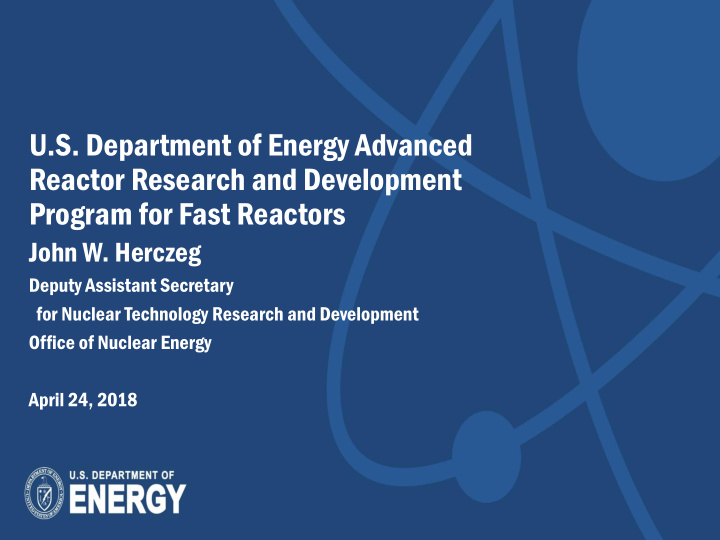



U.S. Department of Energy Advanced Reactor Research and Development Program for Fast Reactors John W. Herczeg Deputy Assistant Secretary for Nuclear Technology Research and Development Office of Nuclear Energy April 24, 2018
Pr Presi esiden dentia tial l an and Depar d Departme tmental ntal Nuclear uclear Ener Energy gy Pri Priori orities ties • President Trump ordered review of nuclear energy policy: “[W]e will begin to revive and expand our nuclear energy sector…which produces clean, renewable and emissions - free energy. A complete review of U.S. nuclear energy policy will help us find new ways to revitalize this crucial energy resource.” Nuclear energy role as clean baseload power is key to • environmental challenges: “If you really care about this environment that we live in…then you need to be a supporter of this amazingly clean, resilient, safe, reliable source of energy.” Secretary Rick Perry at Press conference, May 10 th • Executive Order Promoting Energy Independence and Economic Growth • Commercialization of advanced SMRs crucial to future of US nuclear sector 2
DOE-NE MISSION AND PRIORITIES MISSION PRIORITIES DOE-NE MISSION • Advance nuclear power as a resource capable of making major contributions in meeting our Existing Fleet Nation’s energy supply, environmental and energy security needs • Seek to resolve technical, cost, safety security, Advanced Reactor Pipeline and regulatory issues through RD&D • By focusing on the development of advanced nuclear technologies, support the goals of Fuel Cycle Infrastructure providing domestic sources of secure energy, reducing greenhouse gases, and enhancing national security. RD&D INFRASTRUCTURE VTR TREAT ADVANCED REACTORS LWR LIFE EXTENSION (80 yrs) NUCLEAR HYBRID ENERGY LWR LIFE EXTENSION (60 yrs) ADVANCED LWR FUELS SUSTAINABLE FUEL CYCLE USED FUEL STORAGE SMALL MODULAR REACTORS GEOLOGIC REPOSITORY 2010 2020 2030 2040 3
DOE-NE ADVANCED REACTORS PIPELINE REACTOR TYPES 12 X 50 MWe Light-Water Based SMRs e.g. NuScale High-Temperature Reactors Prismatic & pebble bed designs • Helium Cooled • Molten Salt Cooled • Emphasis: TRISO fuel and Graphite qualification Liquid Fueled Reactor (Molten Salt) • Fast-, thermal- and hybrid-spectrum designs Xe-100 Pebble-Bed Reactor (200 MWth) Metal-cooled Fast Spectrum Reactors Micro Reactors 4 AREVA - HTGR
ADVANCED REACTOR TECHNOLOGIES FOCUS AREAS Advanced Light Water Reactors Fast Reactor Technologies • Demonstrate feasibility of advanced systems and component technologies • Methods and code validation to support design and licensing • Advanced alloy materials qualification for metal-cooled systems TerraPower Gas Reactor Technologies MCFR • Advanced alloy and graphite materials qualification for high temperature gas-cooled systems Scaled integral experiments to support design and licensing • • TRISO-coated particle fuel development and qualification Molten Salt Reactor Technologies • Investigate fundamental salt properties GA Gas-cooled • Materials, models, fuels and technologies for salt-cooled and salt-fueled Fast Reactor reactors Cross-Cutting technologies • Advanced energy conversion • Supercritical Carbon Dioxide (sCO2) Brayton Cycle • Micro reactors for remote defense and commercial applications NuScale PWR GE Hitachi 5 PRISM
VERSATILE TEST REACTOR (VTR) IN SUPPORT OF ADVANCED REACTOR TECHNOLOGIES NEAC Advice: • The need for a VTR was established through a series of independent surveys of the potential U.S. user community (industry, DOE programs) and support from international partners resulting in a NEAC report (“Assessment of Missions and Requirements for a new U.S. Test Reactor” 2/2017); it states that “The Ad Hoc NEAC subcommittee recommends that DOE-NE proceed immediately with pre-conceptual planning activities to support a new test reactor (including cost and schedule estimates).” Goals: • 3 year R&D effort, along with appropriate reviews and planning, leading to an operational VTR by 2026 • VTR would support accelerated development of advanced fuels and materials for U.S. advanced reactor vendors, as well as to provide the capability for testing those fuels and materials to support licensing by the Nuclear Regulatory Commission. • VTR with a high fast neutron flux would revitalize our research infrastructure and remove a critical impediment for U.S. developers of advanced nuclear energy technologies. • Constructed and operated under DOE authority, in close collaborations with NRC. • $35 million in 2017 Omnibus Bill for versatile fast test reactor’s R&D activities to achieve CD-0 in January 2019. 6
SUMMARY The demand for domestically-generated, reliable, and clean sources of base- load electricity will continue to drive many countries toward nuclear energy as part of their “energy security” and national economic and environmental calculus. Profound opportunity for new nuclear growth: • Strong global market interest • Growing need for increased global access to electricity • Support energy security, economic and environmental goals • U.S. leadership to ensure safety & nonproliferation are as important as ever The Administration is committed to advancing nuclear energy in the United States and abroad. 7 “Nuclear energy is a critical component of America’s energy future, and entrepreneurs are developing promising new technologies that could truly spur a renaissance in the United States and around the world.” 7
Back Up Slide
DRAFT REQUIREMENTS/ASSUMPTIONS OF VERSATILE TEST REACTOR (VTR) 1. Approach to Design: Conducting a 3 year research & development effort on core design. 2. Reach fast flux of approximately 4.E15 n/cm 2 -s, with prototypical spectrum 3. Load factor: as large as possible (maximize dpa/year to > 30 dpa/year) 4. Provide flexibility for novel experimental techniques 5. Be capable of running loops representative of typical fast reactors (Candidate Coolants: Na, Lead, LBE, Gas, Molten Salt) – May be a single location with replaceable loops. 6. Effective testing height ≤ 1 m 7. Ability to perform large number of 4 experiments simultaneously 8. Metallic driver fuel (possible options: LEU, Pu, LEU+Pu) 9
Recommend
More recommend